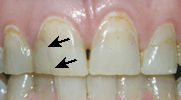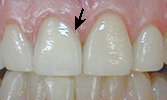|
 A
crown fits over the entire top of the tooth above the gum
line. Crowns cover, protect, seal and strengthen a
tooth. A crown is needed when a filling
just will not work. A crown may be made of gold, white porcelain,
or porcelain fused to gold. There are many situations that
may call for a crown: A
crown fits over the entire top of the tooth above the gum
line. Crowns cover, protect, seal and strengthen a
tooth. A crown is needed when a filling
just will not work. A crown may be made of gold, white porcelain,
or porcelain fused to gold. There are many situations that
may call for a crown:
 Large
decay. If a tooth has decay
so deep and large that a filling
will not stay, or if the tooth structure is weakened, a crown
must be placed on the tooth to save it. Large
decay. If a tooth has decay
so deep and large that a filling
will not stay, or if the tooth structure is weakened, a crown
must be placed on the tooth to save it.
 Large
old fillings. When large old
fillings break down, or get decay
around them, they usually need to be crowned. It is important
to crown a tooth that has been structurally weakened to prevent
a cracked or broken tooth. Once a tooth breaks, it may not
be possible to save it. Large
old fillings. When large old
fillings break down, or get decay
around them, they usually need to be crowned. It is important
to crown a tooth that has been structurally weakened to prevent
a cracked or broken tooth. Once a tooth breaks, it may not
be possible to save it.
 Cracked
tooth. When a tooth is cracked, a filling
will not seal the crack. A crown has to be placed over the
tooth to hold it and the crack together. If a crown is not
placed on the tooth, the tooth will become sensitive to chewing
pressure, or will eventually break. It is important to crown
a cracked tooth before it breaks, because in some cases
a broken tooth cannot be crowned and must be extracted. Cracked
tooth. When a tooth is cracked, a filling
will not seal the crack. A crown has to be placed over the
tooth to hold it and the crack together. If a crown is not
placed on the tooth, the tooth will become sensitive to chewing
pressure, or will eventually break. It is important to crown
a cracked tooth before it breaks, because in some cases
a broken tooth cannot be crowned and must be extracted.
Broken / Fractured tooth.
A tooth that has broken is usually too weak to hold a filling.
A crown will hold the tooth together and prevent it from breaking
again. If the fracture involves the nerve, Root
Canal Therapy may be required before the tooth is crowned.
In some cases, a broken tooth cannot be saved and must be
extracted.
 This
patient chose not to have the cracked tooth above crowned,
and it later fractured. This tooth had to be extracted because
it cracked all the way to the root. This
patient chose not to have the cracked tooth above crowned,
and it later fractured. This tooth had to be extracted because
it cracked all the way to the root.
Sensitive teeth. Teeth
that are very sensitive, either from a lot of "wear," or from
receded gums, sometimes require crowns to seal and protect
the teeth from hot and cold sensitivity.
Root Canal Therapy. A
tooth that has undergone Root Canal Therapy will need a crown
to properly seal and protect the tooth. A tooth with Root
Canal Therapy is more brittle than a tooth with a healthy
nerve and blood supply. A crown provides the necessary support
to the tooth.
 In
cosmetic dentistry, crowns
(sometimes called "caps") are used less
frequently since the advent of veneers,
but in some cases a crown may be necessary for a particular
tooth. A tooth with a bad fracture
or a large filling may be a candidate
for a crown instead of a veneer. In
cosmetic dentistry, crowns
(sometimes called "caps") are used less
frequently since the advent of veneers,
but in some cases a crown may be necessary for a particular
tooth. A tooth with a bad fracture
or a large filling may be a candidate
for a crown instead of a veneer.
 Before:
This tooth has a large filling as shown. A crown is needed
on this tooth, instead of a veneer, because there isn't enough
natural tooth left to support a veneer. A crown will cover
and protect the tooth, but will look the same as a veneer. Before:
This tooth has a large filling as shown. A crown is needed
on this tooth, instead of a veneer, because there isn't enough
natural tooth left to support a veneer. A crown will cover
and protect the tooth, but will look the same as a veneer.
 After:
The top teeth now have veneers, except the one that had the
large filling, which now has a crown. After:
The top teeth now have veneers, except the one that had the
large filling, which now has a crown.
|













 A
crown fits over the entire top of the tooth above the gum
line. Crowns cover, protect, seal and strengthen a
tooth. A crown is needed when a
A
crown fits over the entire top of the tooth above the gum
line. Crowns cover, protect, seal and strengthen a
tooth. A crown is needed when a  Large
Large
 Large
old
Large
old  Cracked
tooth
Cracked
tooth This
patient chose not to have the cracked tooth above crowned,
and it later fractured. This tooth had to be extracted because
it cracked all the way to the root.
This
patient chose not to have the cracked tooth above crowned,
and it later fractured. This tooth had to be extracted because
it cracked all the way to the root. In
In
 Before:
This tooth has a large filling as shown. A crown is needed
on this tooth, instead of a veneer, because there isn't enough
natural tooth left to support a veneer. A crown will cover
and protect the tooth, but will look the same as a veneer.
Before:
This tooth has a large filling as shown. A crown is needed
on this tooth, instead of a veneer, because there isn't enough
natural tooth left to support a veneer. A crown will cover
and protect the tooth, but will look the same as a veneer.
 After:
The top teeth now have veneers, except the one that had the
large filling, which now has a crown.
After:
The top teeth now have veneers, except the one that had the
large filling, which now has a crown.